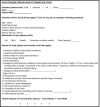Screening cervical spine CT in the emergency department, Phase 2: A prospective assessment of use
- PMID: 23042928
- PMCID: PMC7964472
- DOI: 10.3174/ajnr.A3306
Screening cervical spine CT in the emergency department, Phase 2: A prospective assessment of use
Abstract
Background and purpose: The National Emergency X-Radiography Utilization Study Low-Risk Criteria were established to identify patients with a low probability of cervical spine injury in whom imaging of the cervical spine was unnecessary. The purpose of this study was to ascertain the number of unnecessary cervical spine CT studies on the basis of proper application of established clinical guidelines and, secondarily, to determine indications for ordering studies in the absence of guideline criteria.
Materials and methods: All patients presenting to a level I trauma center for whom a screening cervical spine CT was ordered in the setting of blunt trauma were eligible for enrollment. For each study, the requesting clinician completed a survey regarding study indications. CT examinations were evaluated by a board-certified radiologist blinded to survey data to determine the presence or absence of cervical spine injury.
Results: Of 507 CT examinations, 5 (1%) were positive and 497 (98.0%) were negative for acute cervical spine injury. Five studies (1%) were indeterminate for acute injury but demonstrated no abnormality on subsequent imaging and clinical follow-up. Of the 502 studies without cervical spine injury, 81 (16.1%) were imaged despite meeting all 5 NEXUS criteria for nonimaging. Of these, the most common study indication was dangerous mechanism of injury (48.1%) followed by subjective neck pain (40.7%).
Conclusions: Strict application of NEXUS criteria could potentially reduce the number of screening cervical spine CT scans in the setting of blunt trauma; this change would avoid a considerable amount of unnecessary radiation and cost.
Figures
References
-
- Pitts SR, Niska RW, Xu J, et al. . National Hospital Ambulatory Medical Care Survey: 2006 Emergency Department Summary—National Health Statistics Reports; No 7. Hyattsville, Maryland: National Center for Health Statistics; 2008 - PubMed
-
- Dickinson G, Stiell IG, Schull M, et al. . Retrospective application of the NEXUS low-risk criteria for cervical spine radiography in Canadian emergency departments. Ann Emerg Med 2004;43:507–14 - PubMed
-
- Bailitz J, Starr F, Beecroft M, et al. . CT should replace three-view radiographs as the initial screening test in patients at high, moderate, and low risk for blunt cervical spine injury: a prospective comparison. J Trauma 2009;66:1605–09 - PubMed
-
- Greenbaum J, Walters N, Levy PD. An evidence based approach to radiographic assessment of cervical spine injuries in the emergency department. J Emerg Med 2009;36:64–71 - PubMed
-
- Griffen MM, Frykberg ER, Kerwin AJ, et al. . Radiographic clearance of blunt cervical spine injury: plain radiograph or computed tomography scan? J Trauma 2003;55:222–26, discussion 226–27 - PubMed
MeSH terms
LinkOut - more resources
Full Text Sources
Medical


